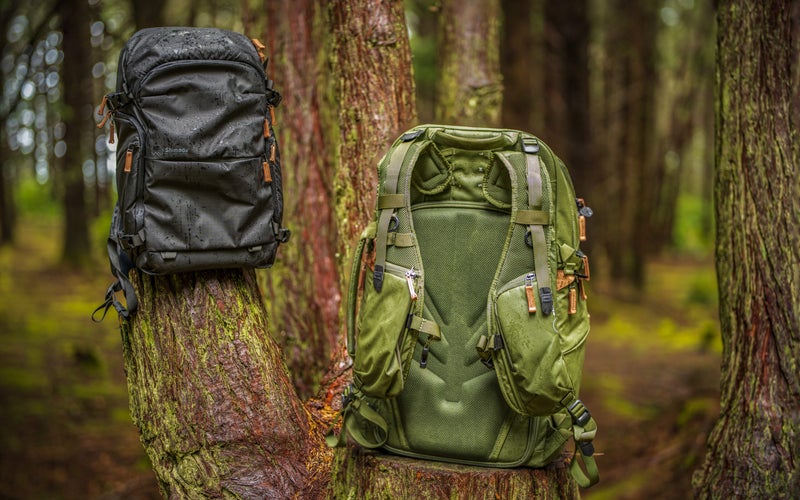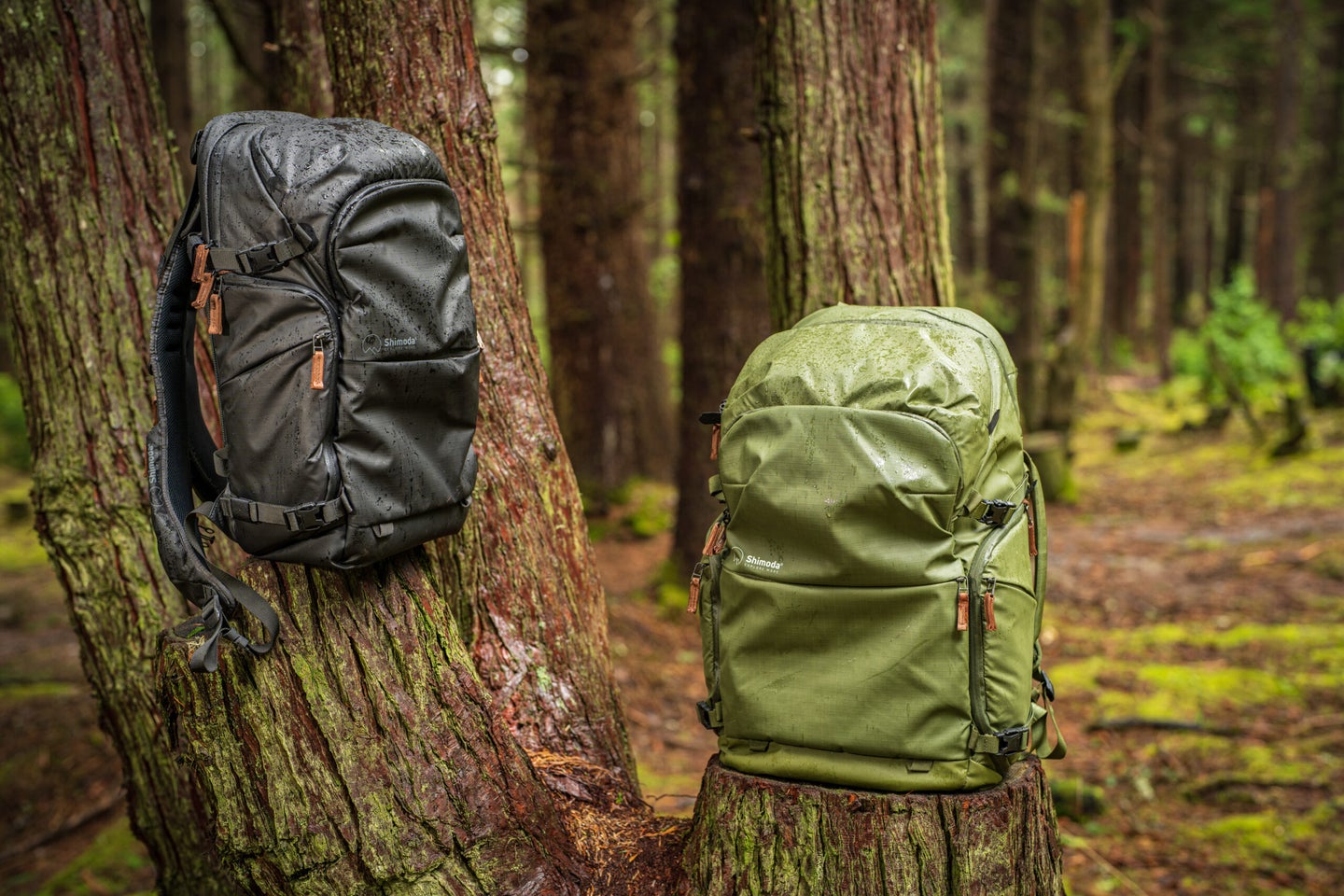
In my 40 years as a photographer, I’ve owned dozens of camera bags. Lugging camera gear has always been an exercise of compromises, but with the new Explore v2 camera backpacks from Shimoda Designs, those compromises are few. And I’ve frankly never used a better bag. Actually, I have two of them; the Explore v2 25L and Explore v2 35L packs.
Mason Marsh
I purchased these backpacks and their associated camera “Core Units”—padded interior storage cubes that come in a wide variety of sizes—as part of Shimoda Design’s Kickstarter campaign last year. I’ve been using both for several months while on adventures in the American West. They’ve been dragged over the rough granite of California’s Alabama Hills and Joshua Tree and soaked in Oregon’s coastal rain. The Explore v2 packs are hands down the most complete camera-carry solution I’ve ever used. We even gave them a 2021 Pop Award for gear excellence.
An evolution in design and aesthetics
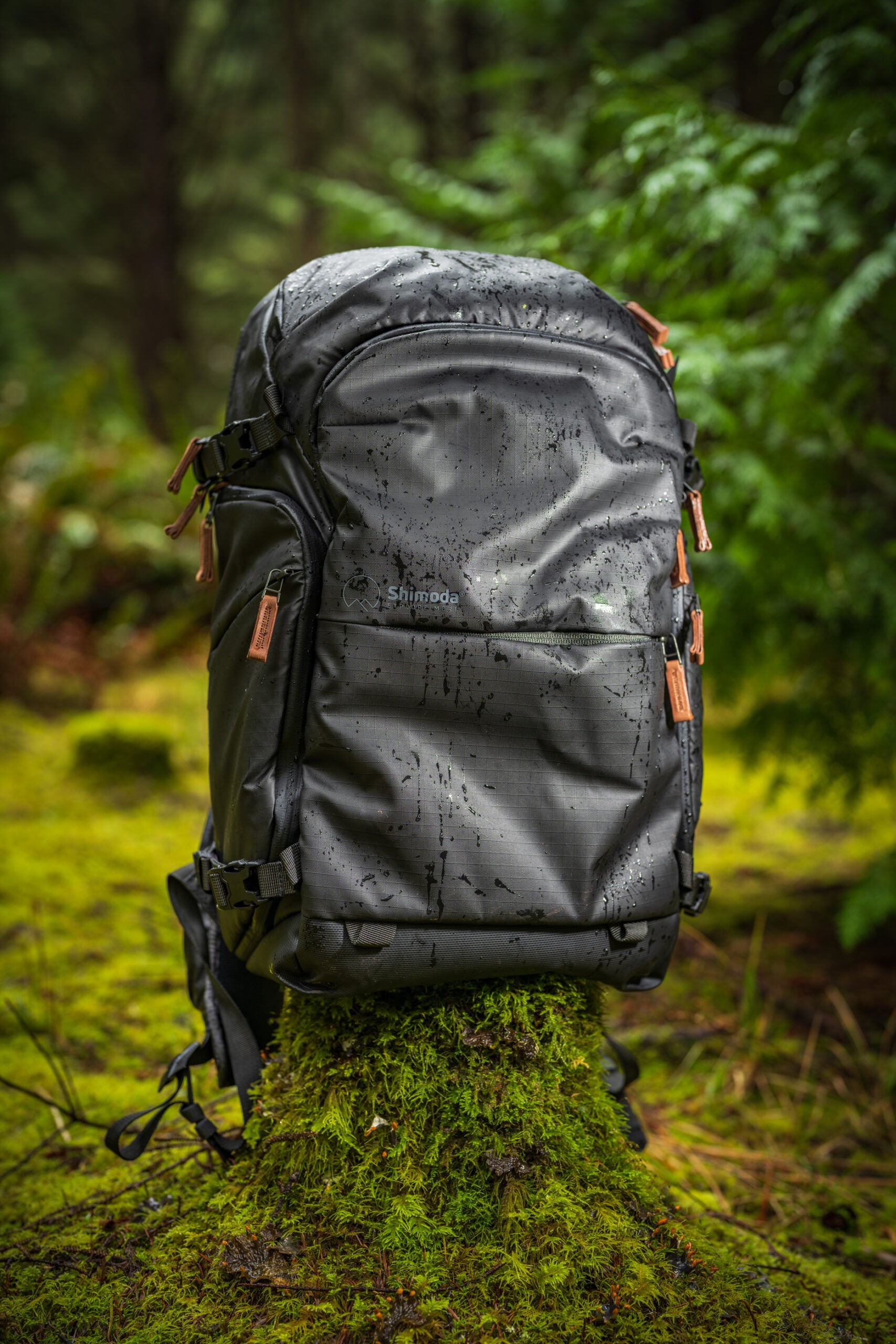
Adventure, nature, and travel photographers are always in search of incredible images in exotic locations, and capturing those images often requires a lot of gear; heavy, expensive and fragile stuff. When miles separate image-makers from their locations, a camera backpack is the best option for lugging precious equipment to where the shots are made.
In 2017, veteran camera pack designer Ian Millar launched a new line of adventure-forward camera bags with unique shoulder straps (adorned with pockets) and adaptable cube-and-hatch configurations for carrying variable loads. Shimoda Designs started with the Explore v1 line of backpacks and a travel-focused roller bag. Soon after, adventurous photographers around the world were sporting the brand’s distinctive minty green and dark blue backpacks. Four years later, Shimoda Designs is back with the evolved Explore v2 lineup. These rugged bags look less like backcountry gear thanks to understated colors, leather accents, and sleek exteriors with minimal straps. While they are adventure-ready, they don’t look out of place in urban environments.
The Explore v2 packs join Shimoda Designs’ Action X line of packs, which are unabashedly utilitarian with features outdoor and adventure photographers require for work in severe conditions and over miles of torturous terrain. Millar likes to describe the Action X packs as the “pickup trucks” of Shimoda’s line. The new Explore packs, on the other hand, he considers more akin to SUV’s.
All of Shimoda’s packs are designed and built to withstand merciless use in extreme situations, but the Explore v2 line is aimed squarely at photographers who’d like a robust camera backpack that doesn’t look like they just wrapped up an expedition. While the other Action X packs come in 30-, 50- and 70-liter capacities, the Explore v2 packs come in 25-, 30-, and 35-liters. The smallest 25-liter pack is designed to satisfy the most-stringent international airline carry-on rules and all three of the v2 packs are sized to meet domestic carry-on requirements.
It all starts with the straps
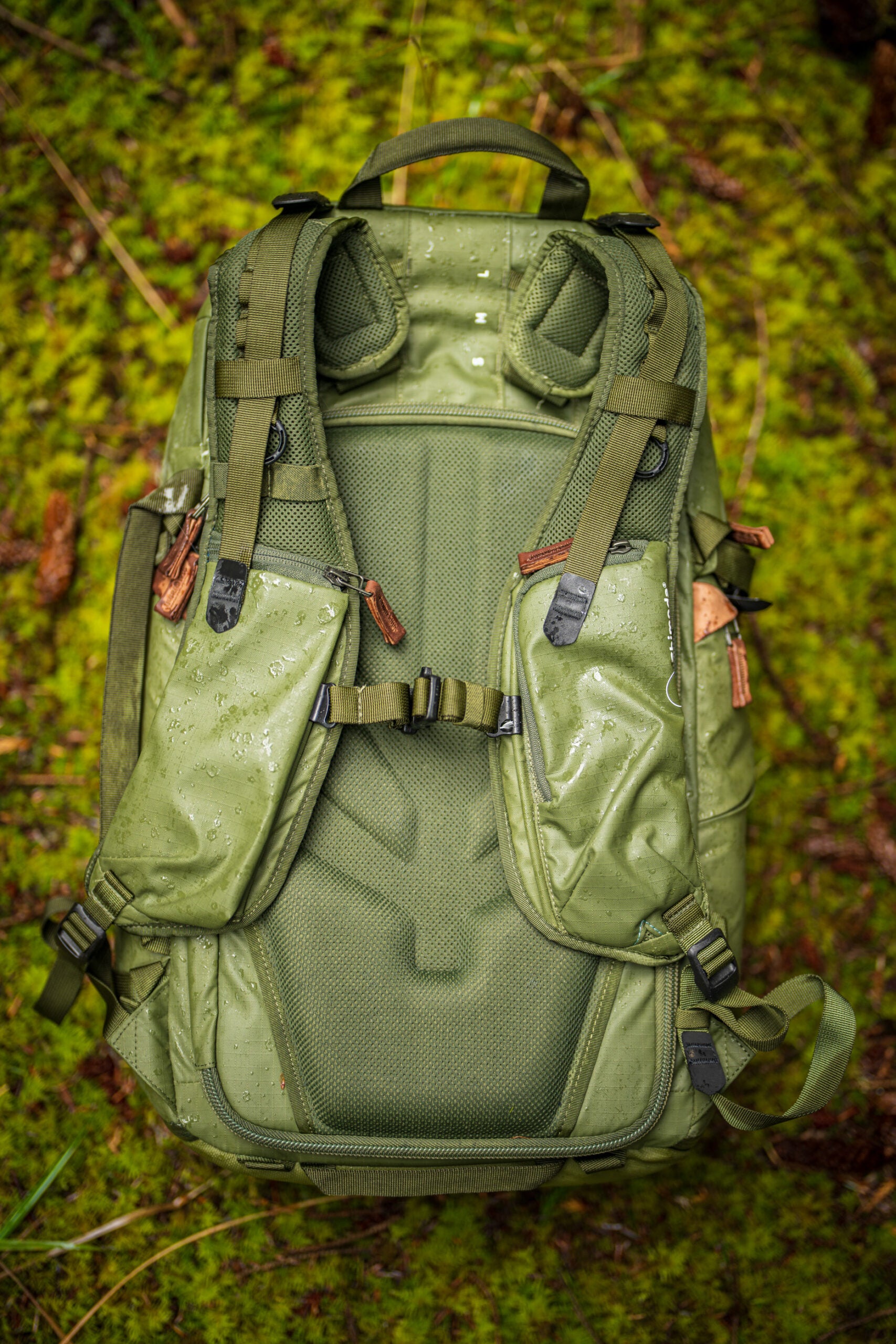
For all of their innovations over the years, backpacks have largely kept the same basic design for the shoulder straps we rely on to hang much of the weight of a pack on our bodies. For those heading out on quick day hikes with little more than an extra jacket and some snacks, a simple set of straps would suffice, but for photographers lugging cargo consisting of a number of dense, heavy objects, having shoulder straps that can comfortably transfer the weight is the difference between arriving at the destination ready to be creative and showing up sore and surly.
Long-distance backpackers know the joyful utility of having often-needed items within easy reach and often fasten pockets and pouches to their shoulder straps to accommodate those items. The new Shimoda Designs shoulder straps, introduced with the Explore v2 line, feature wide, structured shapes that disperse the load across the chest, while boasting truly useful pockets. The right strap can hold a large smartphone, microfiber cloths, and business cards while the left strap has a stretch pocket suitable for a small water bottle.
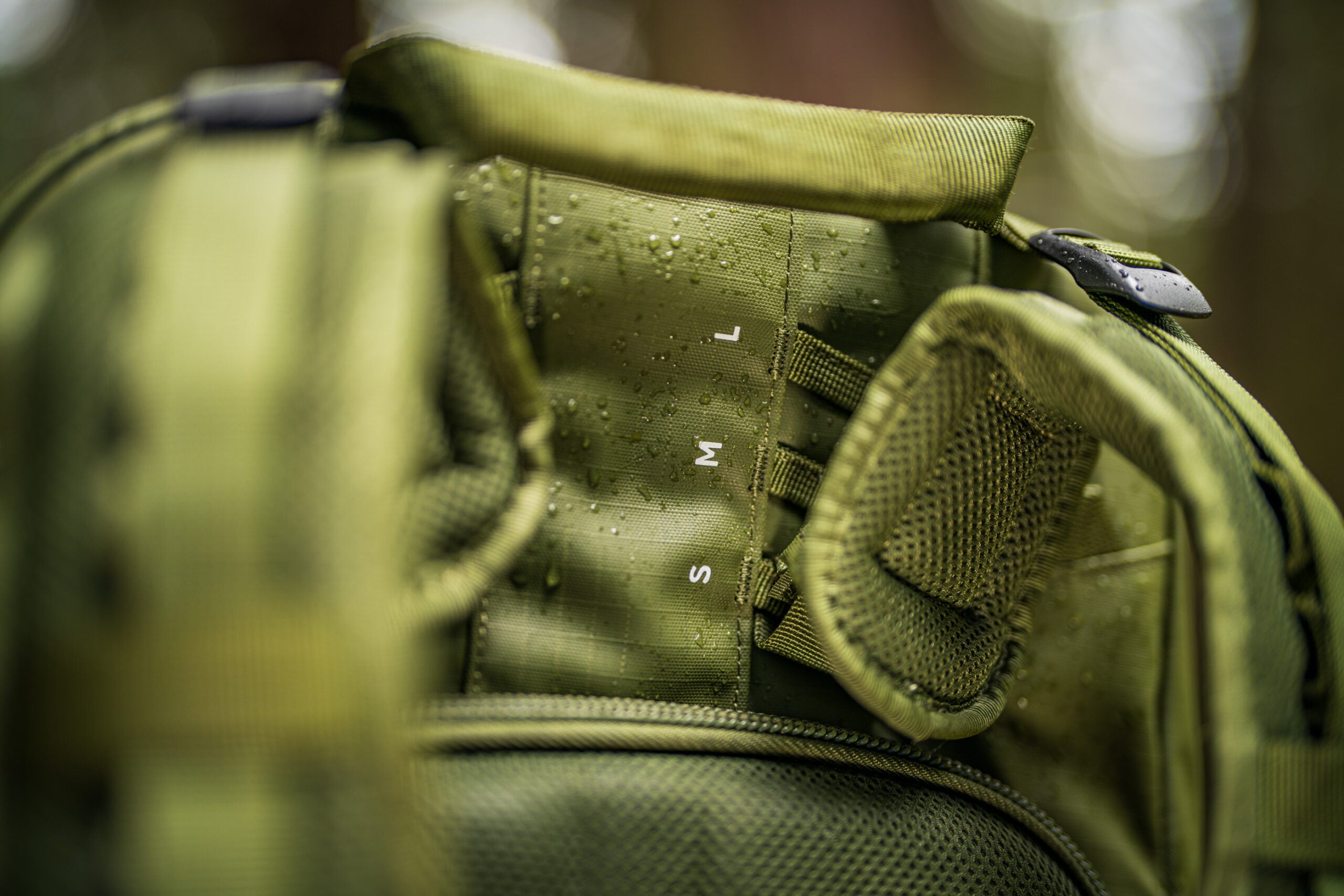
Shimoda Designs backpacks all feature a ladder of nylon webbing attachment points giving users three inches of adjustment for the shoulder straps, a feature not found on most camera packs. This vertical adjustment accommodates various torso lengths further boosting comfort for heavy hauling.
Straps for everyone
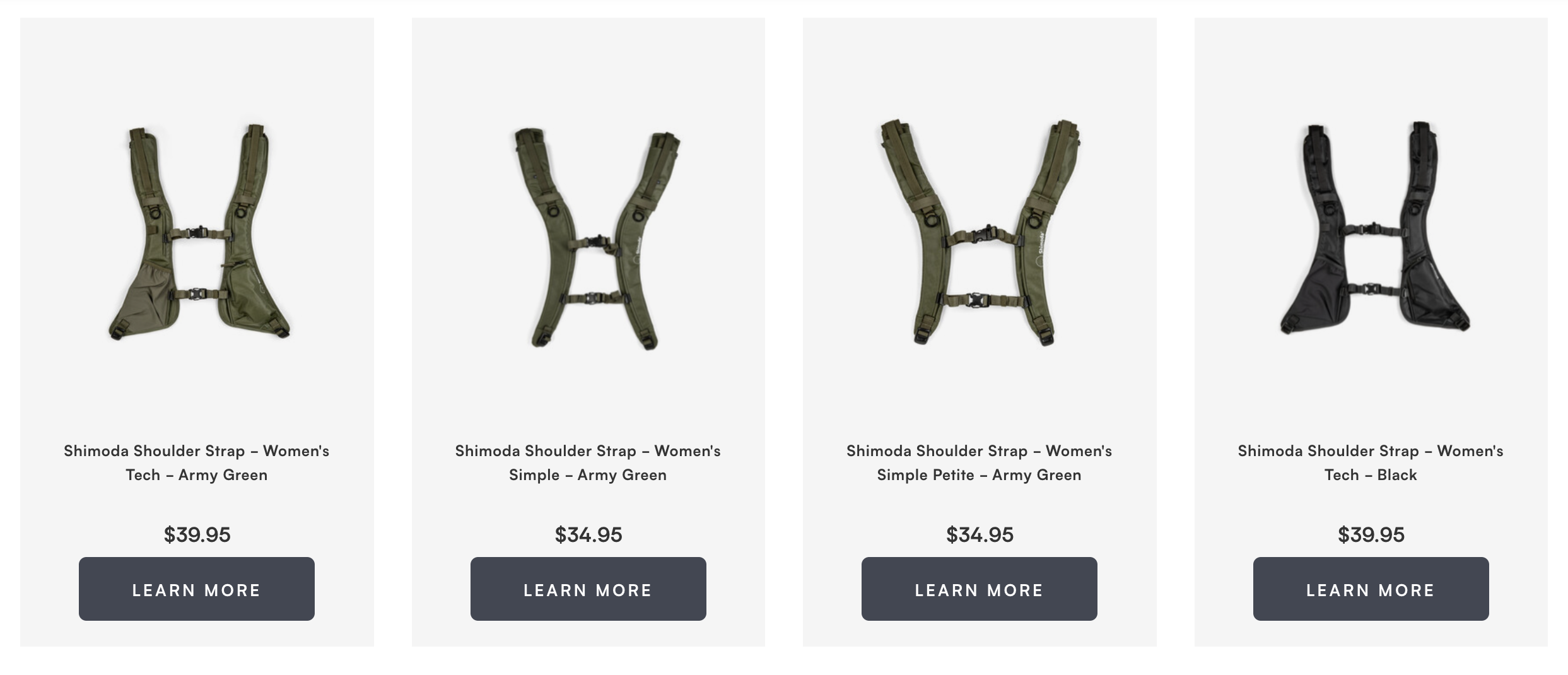
When Millar designed this latest series of packs, he worked with a team of female photographers to create several series of optional shoulder straps specifically built to contour to the female body. The resulting three options: “Simple,” “Tech,” and “Simple Petite” all feature double sternum straps to better distribute the pack’s weight across the chest. The Tech straps retain the wide pocketed style of the original straps and the Simple straps drop the pockets for a more slender and less-obtrusive strap system. In the Action line, Millar also introduced a “Plus-sized” strap on the 70-liter pack. These four optional straps are now available for use on all Shimoda Designs backpacks, making the system one of the most adaptable and customizable on the market.
Camera Core Units
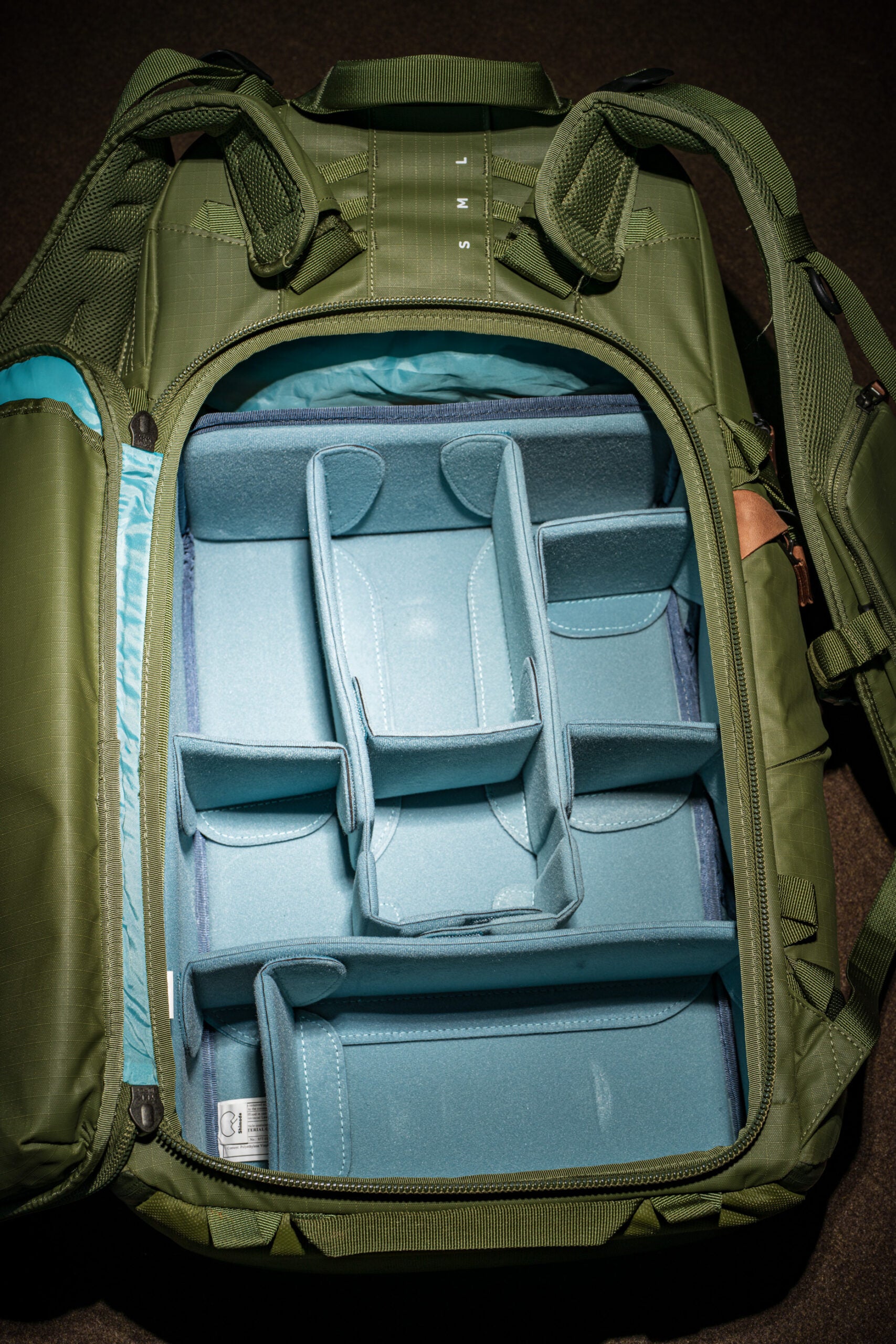
Many photo backpacks feature removable padded “cells.” What sets the Core Units Shimoda offers apart from the competition is their rigidity. All of the brand’s current Core Units have inflexible walls which provide crush protection and help the packs stand upright when on even ground. The mirrorless units, as you would expect, are sized to hold smaller lenses and camera bodies within the 4.7-inch depth. The DSLR units are 6.7 inches deep and can swallow larger lenses and bodies without having to place them on their sides in the cubes. As with all padded internal camera units, Shimoda’s are customizable with plenty of dividers of various lengths that stick together using rip and stick attachments.
With a wide range of Core Units available for the Explore v2 lineup, there are plenty of options for photographers with varying kit sizes.
Good things come in threes
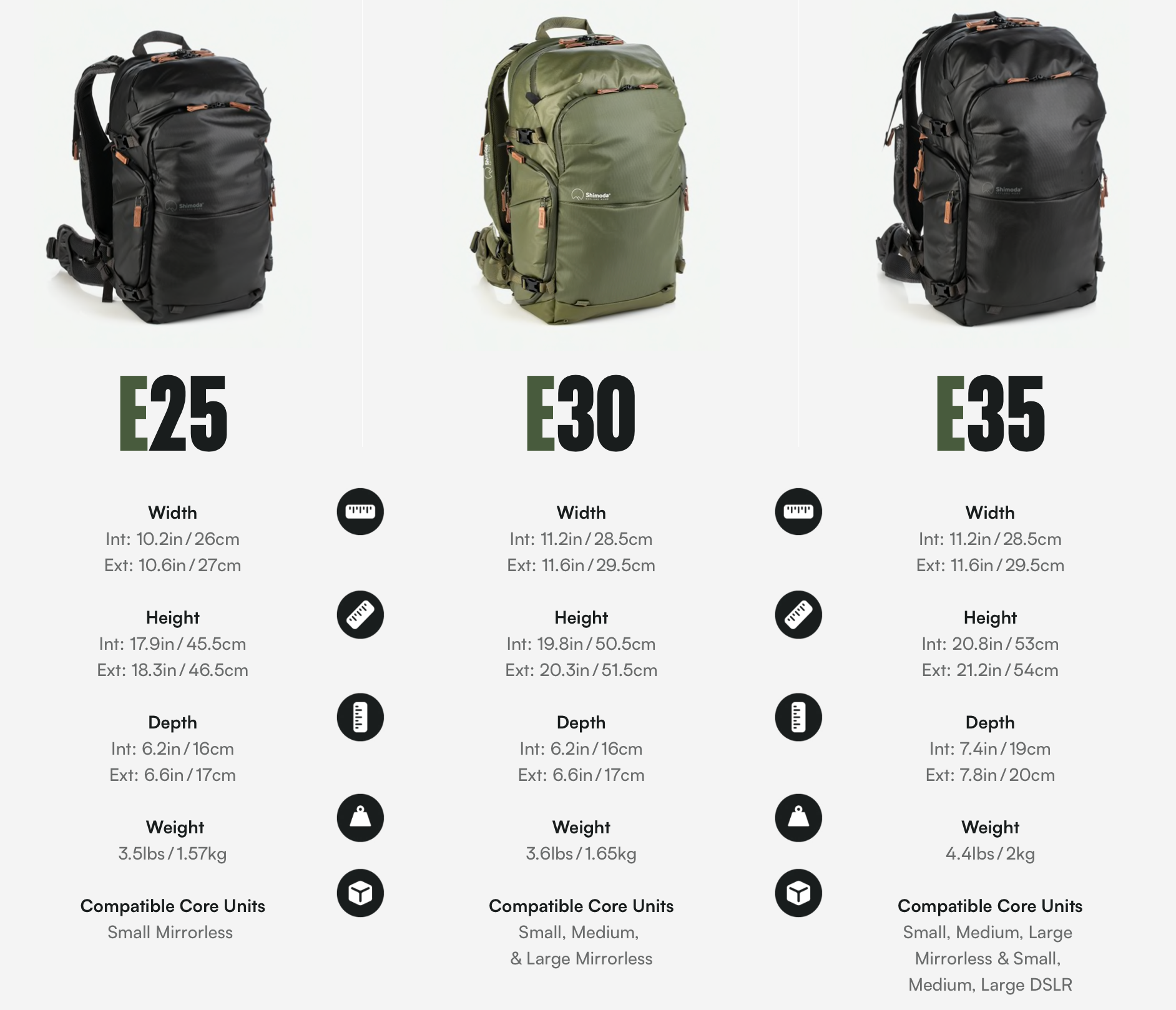
As mentioned, the Explore Version 2 packs span three sizes: 25-, 30- and 35-liters. All three sizes feature the same core features and utilize the same materials. The differences lie in the capacities of the central compartment where the padded Core Units reside. Below is a breakdown of the capacity of each.
Explore 25L – A tidy solution for a small kit
The 25-liter pack is designed to hold only the small mirrorless Core Unit, which is surprisingly capacious for a svelte 10 x 10-inch box. The small unit can carry a mirrorless camera with four or five lenses, making it a great choice for those looking for a bag that will meet strict international airline carry-on rules.
- Exterior Dimensions: 10.6-inches wide, 18.3-inches tall, 6.6-inches deep
- Weight: 3.5 pounds
- Fits up to a 13-inch laptop
Explore 30L – A Goldilocks pack for larger loads
For a larger mirrorless kit, the 30-liter pack finds the sweet spot with room for any of the mirrorless Core Units while keeping a shallow profile that will slide into any overhead bin. The 25- and 30-liter packs share the same depth, but the 30-liter stretches length and depth dimensions to handle larger gear.
- Exterior Dimensions: 11.6-inches wide, 20.3-inches tall, 6.6-inches deep
- Weight: 3.6 pounds
- Fit up to a 16-inch laptop
Explore 35L – For when you have a lot to lug
For those traveling with DSLRs or large mirrorless kits, the 35-liter pack will accept the 2-inch-deeper DSLR Core Units. These extra 5 liters really swallow a lot of gear as most non-telephoto prime and zoom lenses will fit “caps up” and large camera bodies can be stashed grip up. The 35-liter is designed to fit in domestic airline overhead bins, but fully loaded, they will raise the eyebrows of gate agents.
- Exterior Dimensions: 11.6-inches wide, 21.2-inches tall, 7.8-inches deep
- Weight: 4.4 pounds
- Fit up to a 16-inch laptop
Advances in organization
Camera packs that have built-in configurable storage space for camera gear can obviously be adjusted to carry all manner of loads, but where the Shimoda Designs bags shine is all of the organizational and protective spaces that surround the central compartment where the Core Units reside. In the updated Explore v2 packs, there are four areas where photographers will find value: the top compartment, the front pockets, the side pockets, and the laptop sleeve. Let’s start at the top.
Top storage
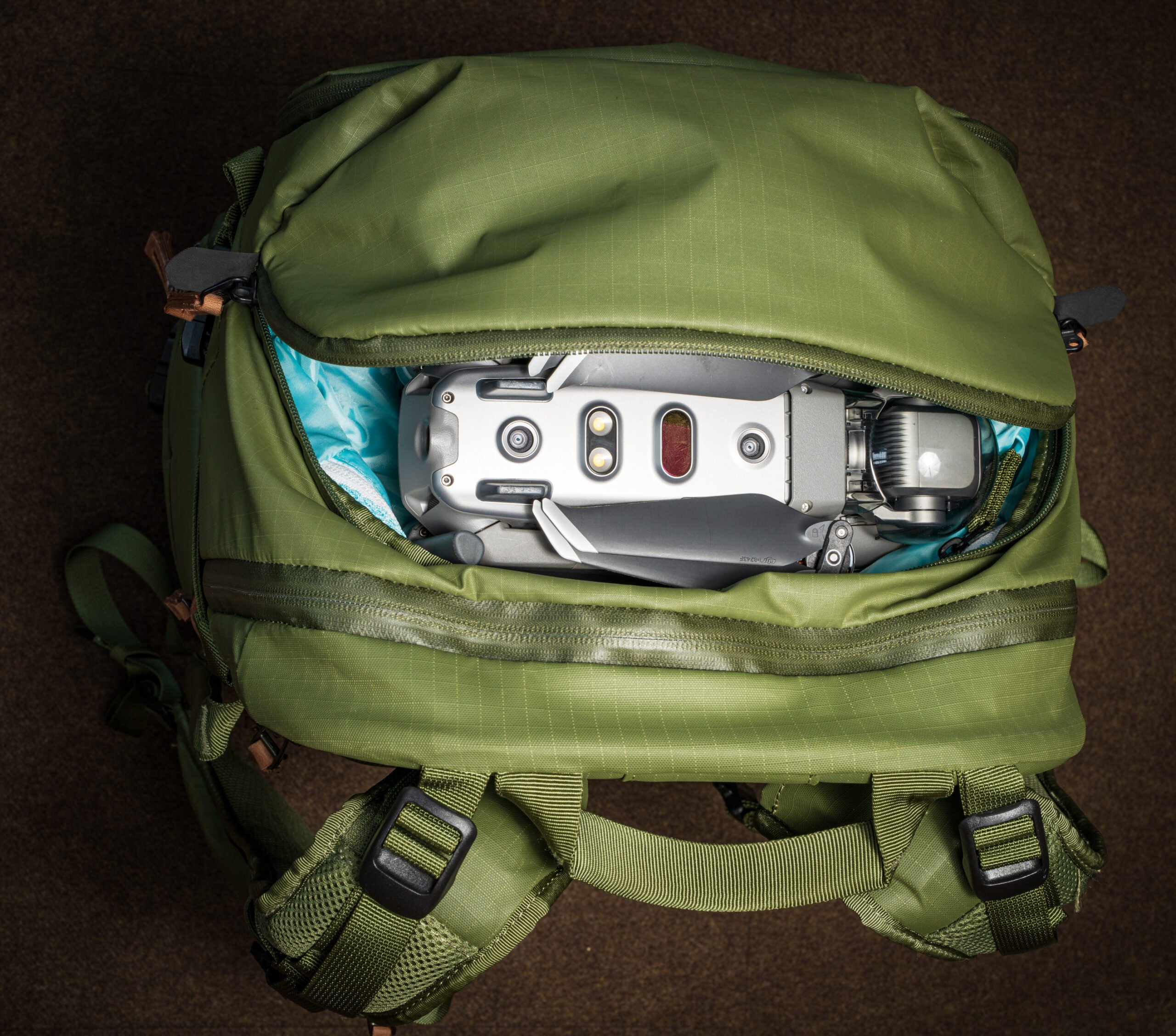
On the original Explore bags, the top compartment is simply a lightweight nylon sack that separates the top portion of the bag from the main compartment. Due to its lightweight construction, it isn’t great for heavy objects like large lenses, gimbals, and drones, but works in a pinch. I tore this compartment free from its interior attachment points in the original pack, but I am happy to see the version two bags take a more robust approach.
The top compartment in the Explore v2 packs is still a hanging sack, but now it’s padded and oversized, allowing for better use of the empty space above whichever internal Core Unit is installed in the main compartment. Like the original, there are three mesh pockets inside. The addition of lightweight padding in the top compartment makes this space a viable place for excess equipment like drones, gimbals, and larger pieces that won’t fit in the Core Unit. In the Explore 25L, I can fit a Sony mirrorless camera body with an attached medium zoom lens. Safely zipped inside, I’m confident it would ride out all but the roughest handling.
Laptop sleeve
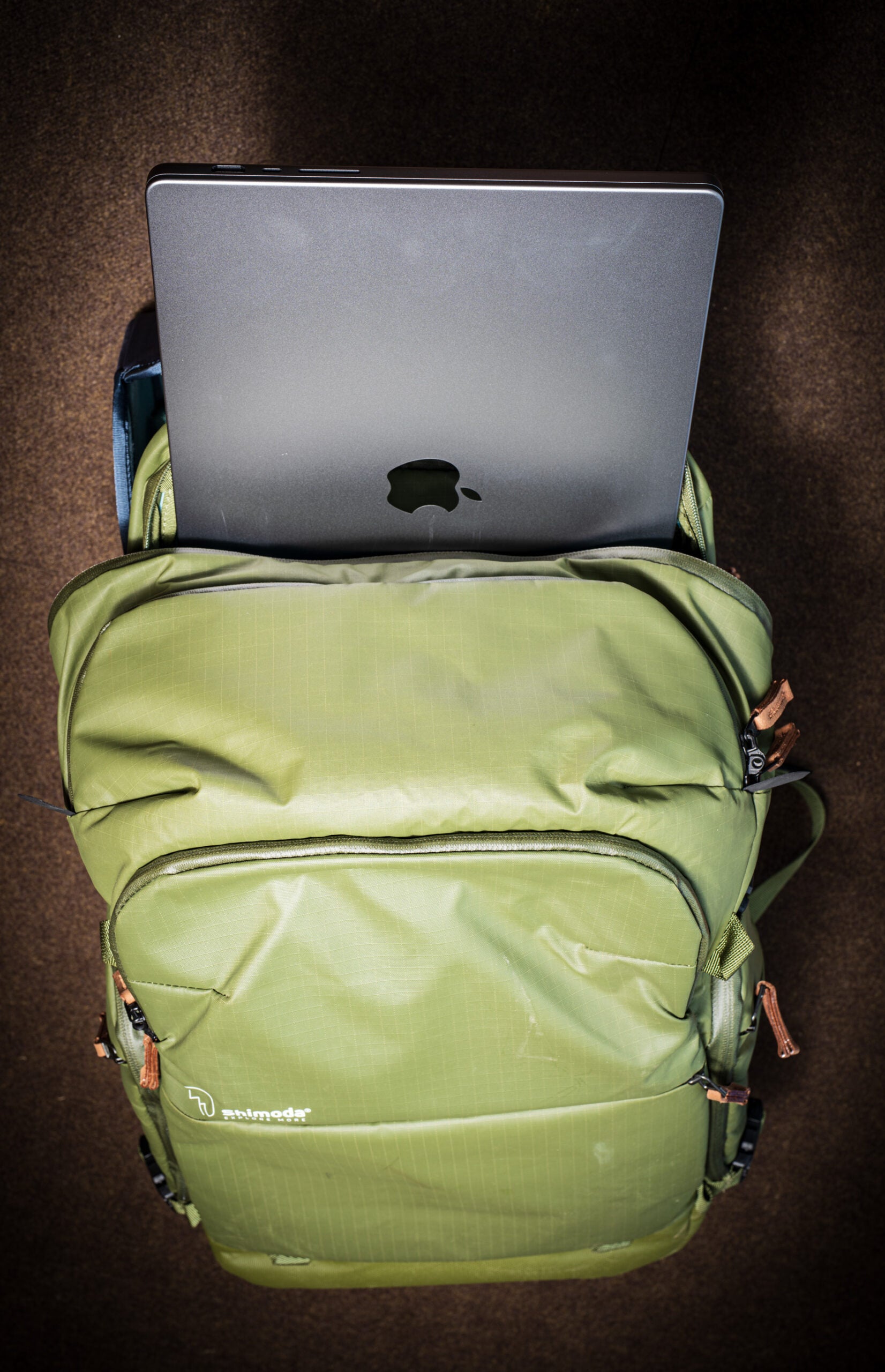
Behind the top compartment is a second weather-resistant zipper that opens to the inside of the main compartment behind the top chamber. This opening allows for access to the laptop sleeve which is housed in the zippered hatch on the back of the pack.
The laptop sleeve is nicely padded and deep enough for the chunkiest computers. That being said, I did struggle to zipper the laptop “hatch” shut when placing the new 16-inch MacBook Pro inside—it protrudes a good bit beyond the curved zipper opening. Also worth noting is the sleeve has no retention strap or flap, so smaller items like iPads or small laptops can easily slide out of the sleeve into the main compartment. Because of these issues, I prefer to carry my laptop in a separate pack when I travel. I use the space for storing microfiber towels and other soft flat items.
Front pockets
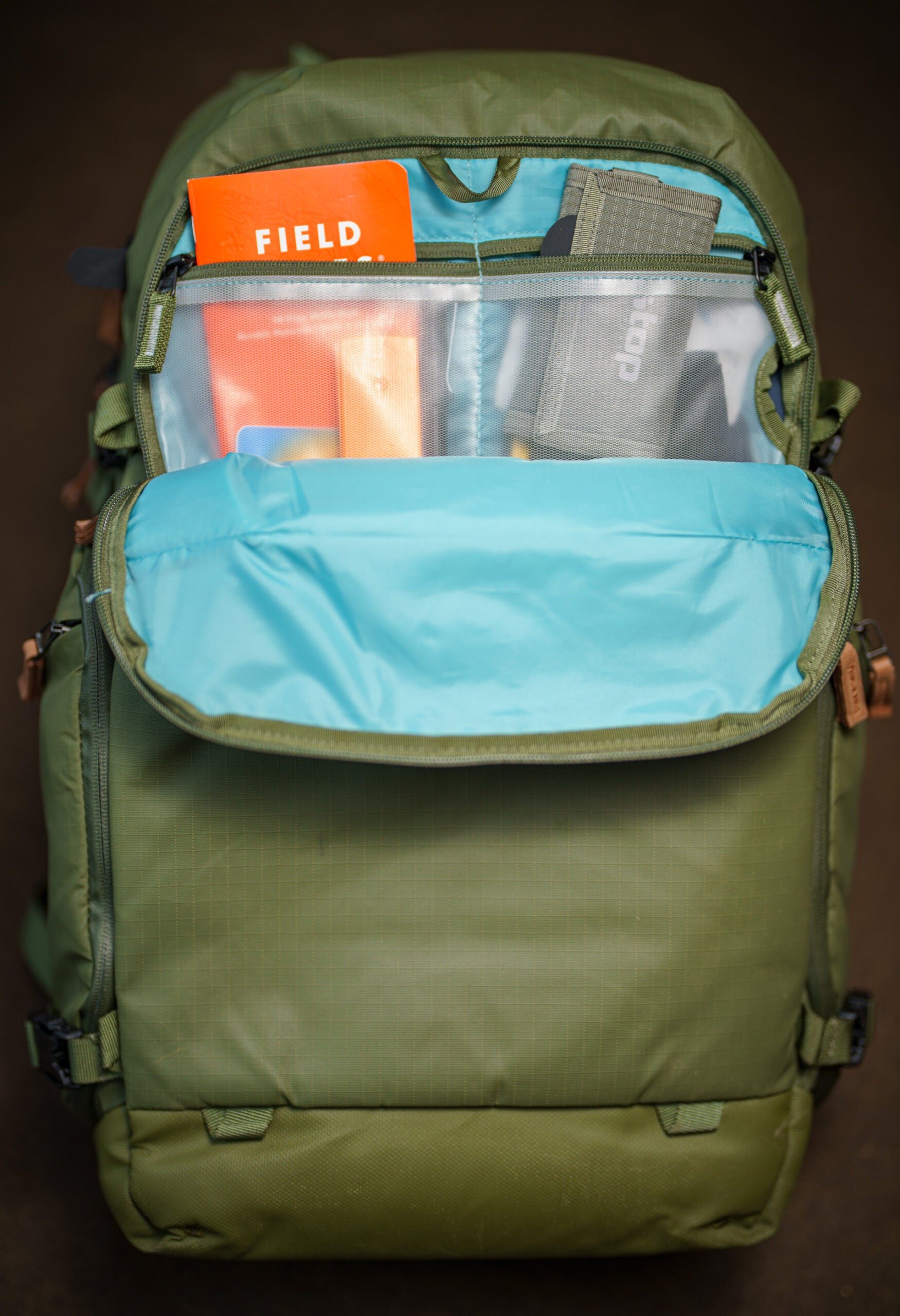
The front pockets on the Explore v2 packs are much improved from the original. They are now slightly padded and structured with the main pocket opening along the top of the bag via a weather-resistant zipper. Inside are two transparent zippered pockets nicely sized to accept filters or other accessories. I can fit a notebook snugly in one along with business cards and a pen. These two pockets sit high at the top of the pack and below is a large stretchy divider that could easily hold a hydration bladder, jacket, or other large items.
If you opt to install a bladder, there is a hanging loop and clever tube routing from the pocket to the shoulder straps. It seems to me that given the thoroughly coated materials of the pack, along with the configuration of this front pocket, a leaking hydration bladder would not pose a risk to the internal camera compartment. Below the main front pocket is a second zippered pocket that provides a separate space for incidental items. This pocket is perfect for snacks and other things you’d like quick access to, but I’d avoid using it for valuables as it’s a conspicuous pocket directly on the back of the bag.
Side pouches
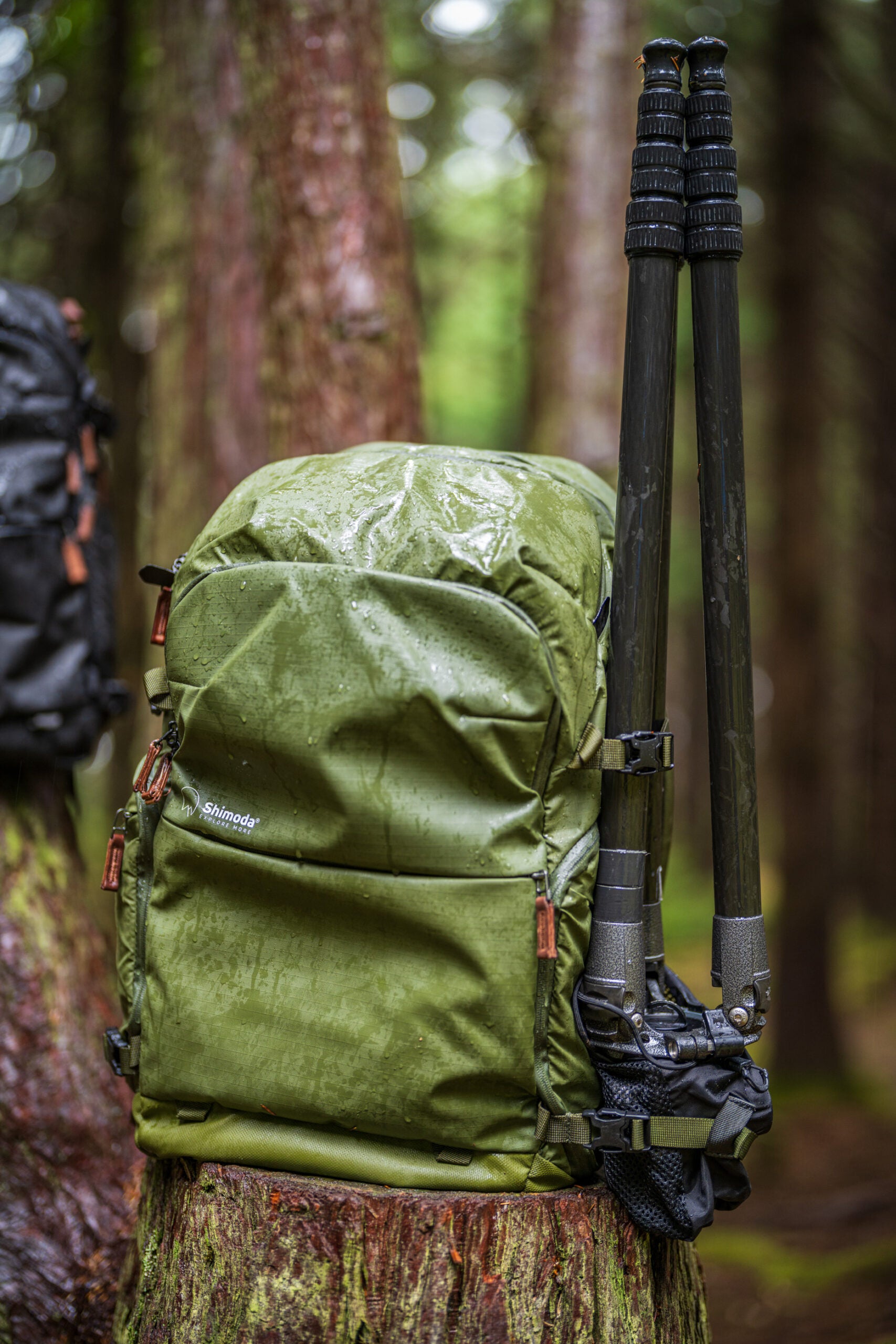
The side pocket of the original Explore packs was a frustration for me. There was only one and it housed a pull-out mesh pocket that was intended to hold a tripod or water bottle on the outside of the pack. That pocket was very large and even when used along with the pack’s side compression straps, tripods and water bottles were floppy. With the Explore v2 packs, there are now zippered pockets on each side and each holds a deployable mesh pouch that is slightly smaller than the version 1 pouch. Used with the pack’s adjustable compression straps, these pockets do a better job of holding water bottles and all but the largest tripods. (My massive Gitzo Systematic tripod is too broad-shouldered to fit, but my Really Right Stuff BH55 ball head fits just fine.)
Zippered side access
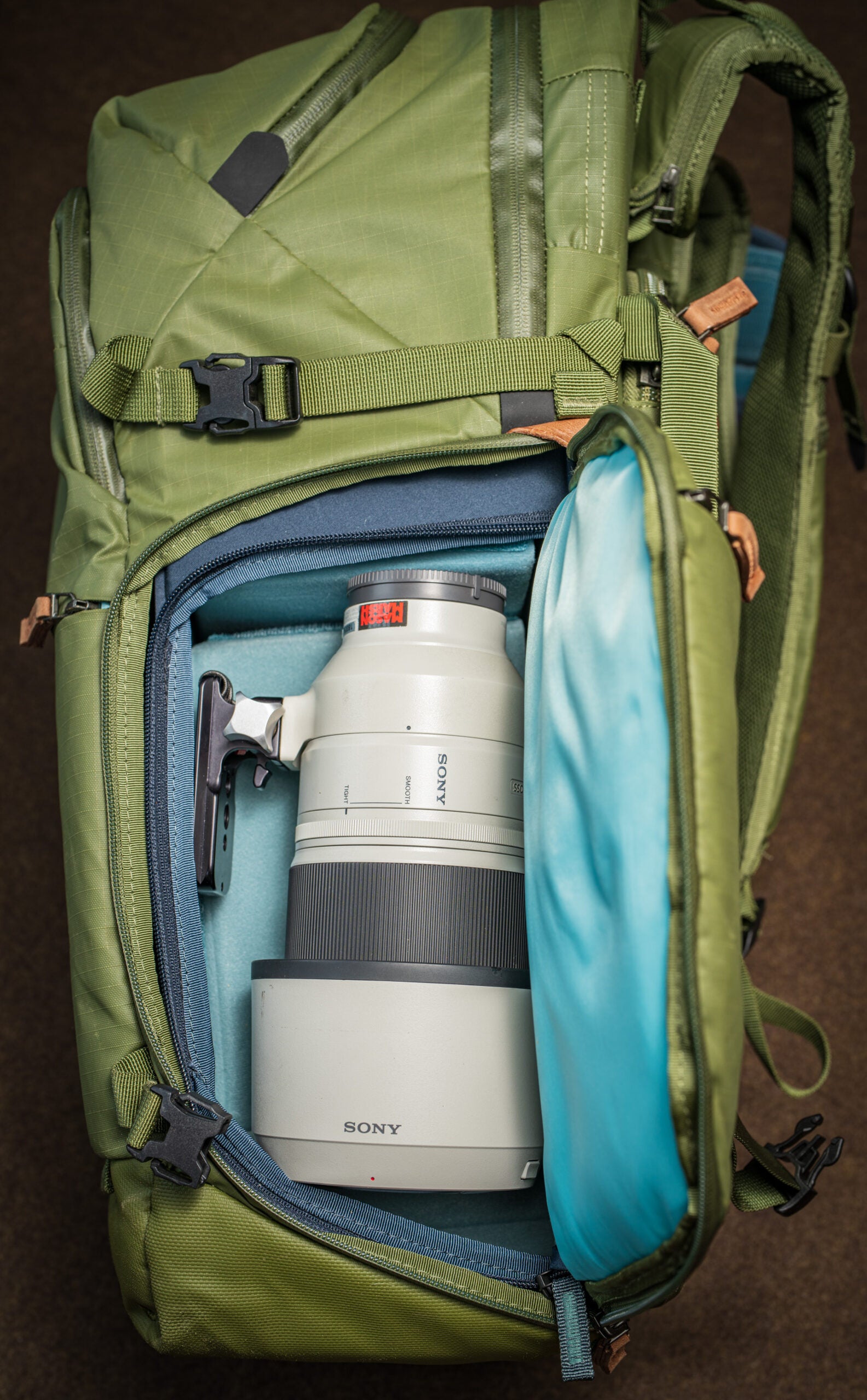
The zippered pockets open like wings and one side allows access to the internal camera unit for those who’d like the option of grabbing their camera without taking off the pack. This wing flap also has a hidden passport pocket, which I think is a welcome addition. The other side opens to a new filter pocket that is divided into two zippered halves. Each is made of transparent material for easy viewing of the pockets’ contents. While they are designed to house large filters, I use them for batteries, SD cards, and other tools I want easy access to.
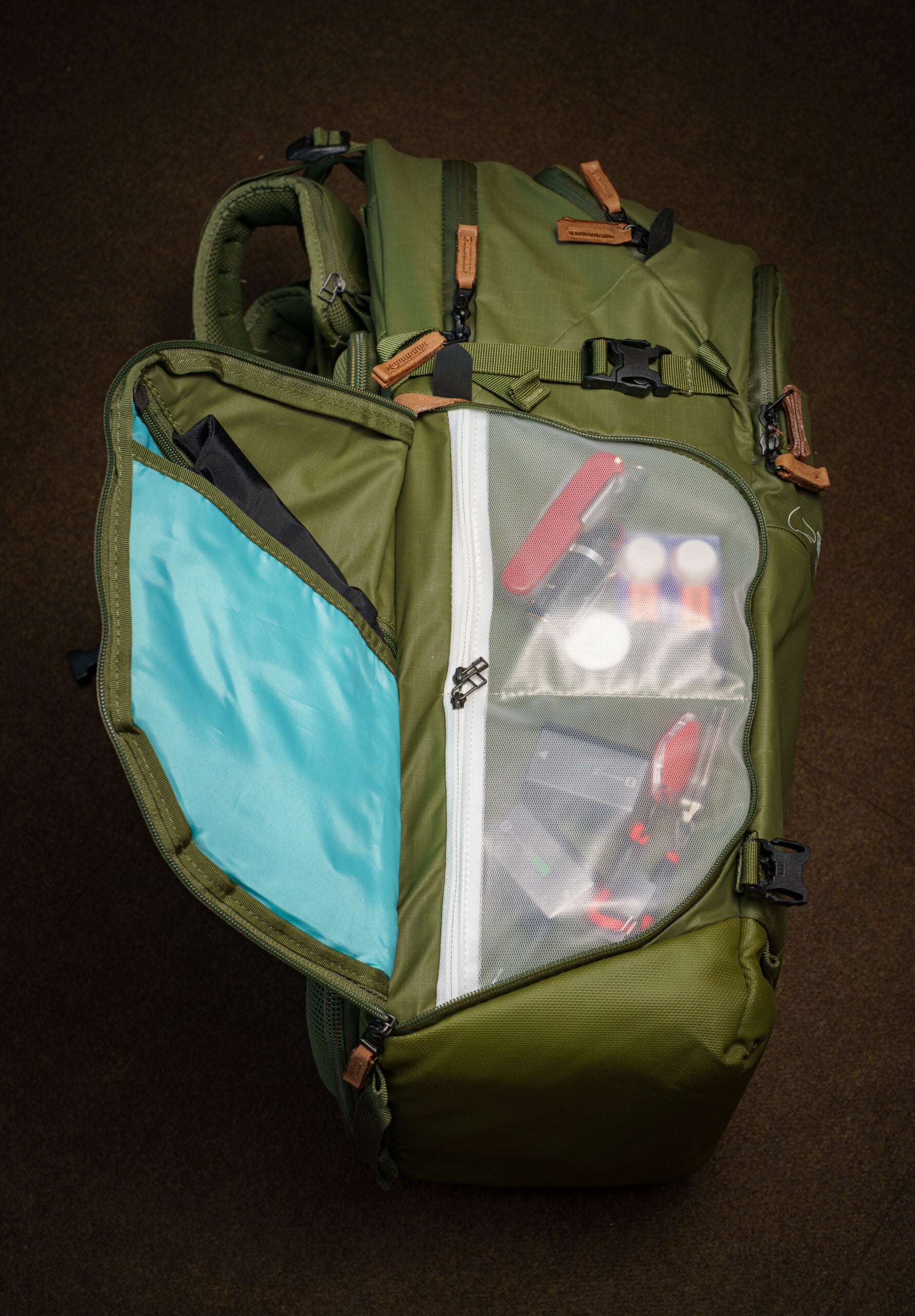
I really appreciate this set of pockets but I have one beef with them: due to the wing design, the flap that opens to reveal these pockets is in the way when the pack is placed face down on the ground. Since these packs are meant to be used this way, with the main compartment opening in the back panel of the pack, this cumbersome pocket access seems odd.
Business in the Back
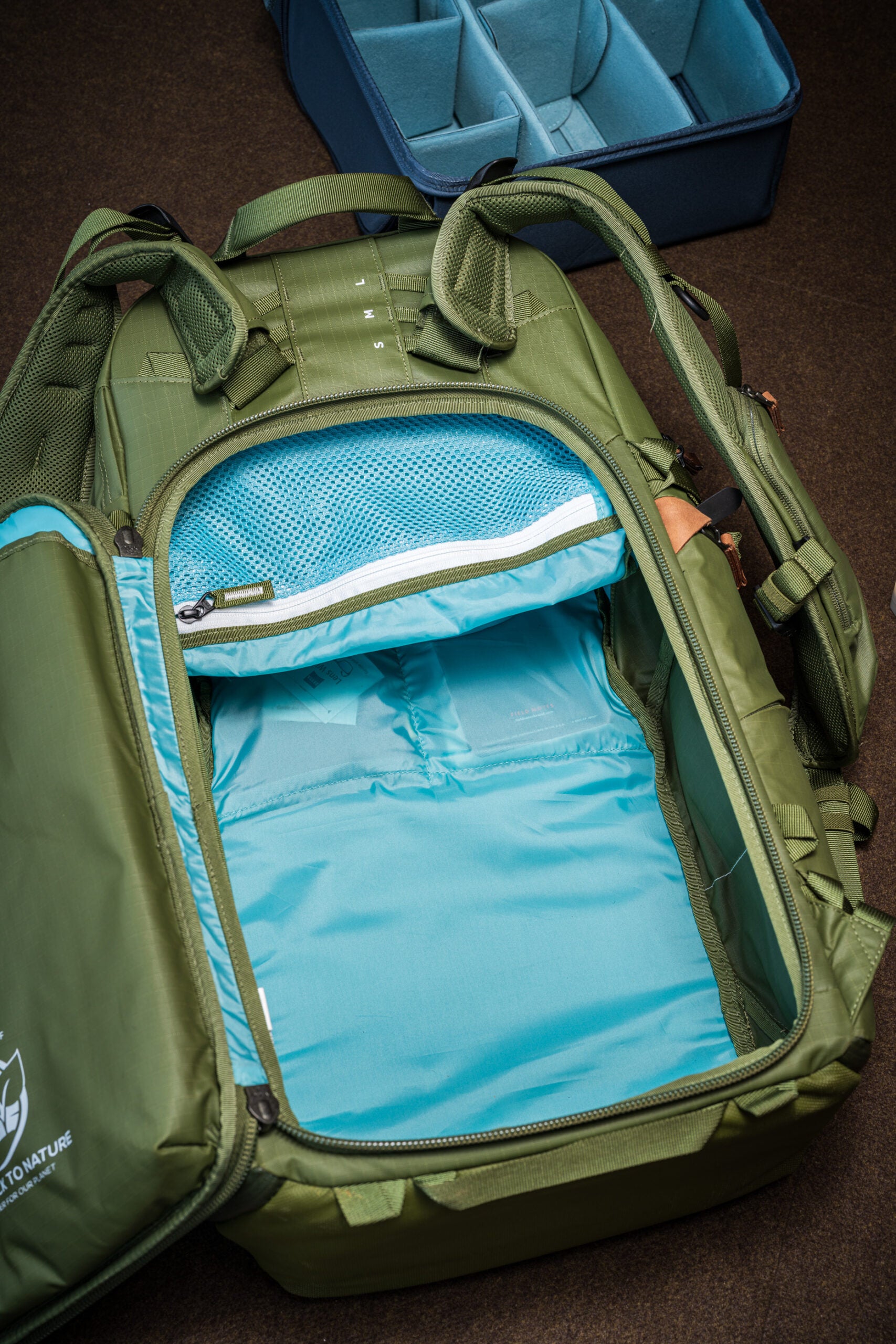
There’s considerable utility in having the main compartment of a camera backpack accessible from the back. First, it prevents anyone from getting to your precious gear while the pack is on your back. Second, when you put the pack down to get to your gear and go to work, having the parts of the pack that aren’t going to go back onto your back touching the wet, sandy, or muddy ground is really nice. When the Explore v2 packs are laid face-down on the ground, you are presented with the large hatch opening which opens to the side like a door. This is another useful feature as it keeps the hatch (and possibly your enclosed laptop up off the ground and out of the way on the side.
Many camera backpacks I’ve used over the years have opened clamshell style with the large flap coming down from the top to layout from the bottom of the pack, often right where I want to kneel. Millar took notes watching photographers working from their “desks” on the ground and added a grab handle to the bottom edge of the packs so users could pick up and move them easily with their bags open. I’ve found this quiet little addition to be a real pleasure when I need to shift my workspace in the field and I don’t want to have to zip everything back up.
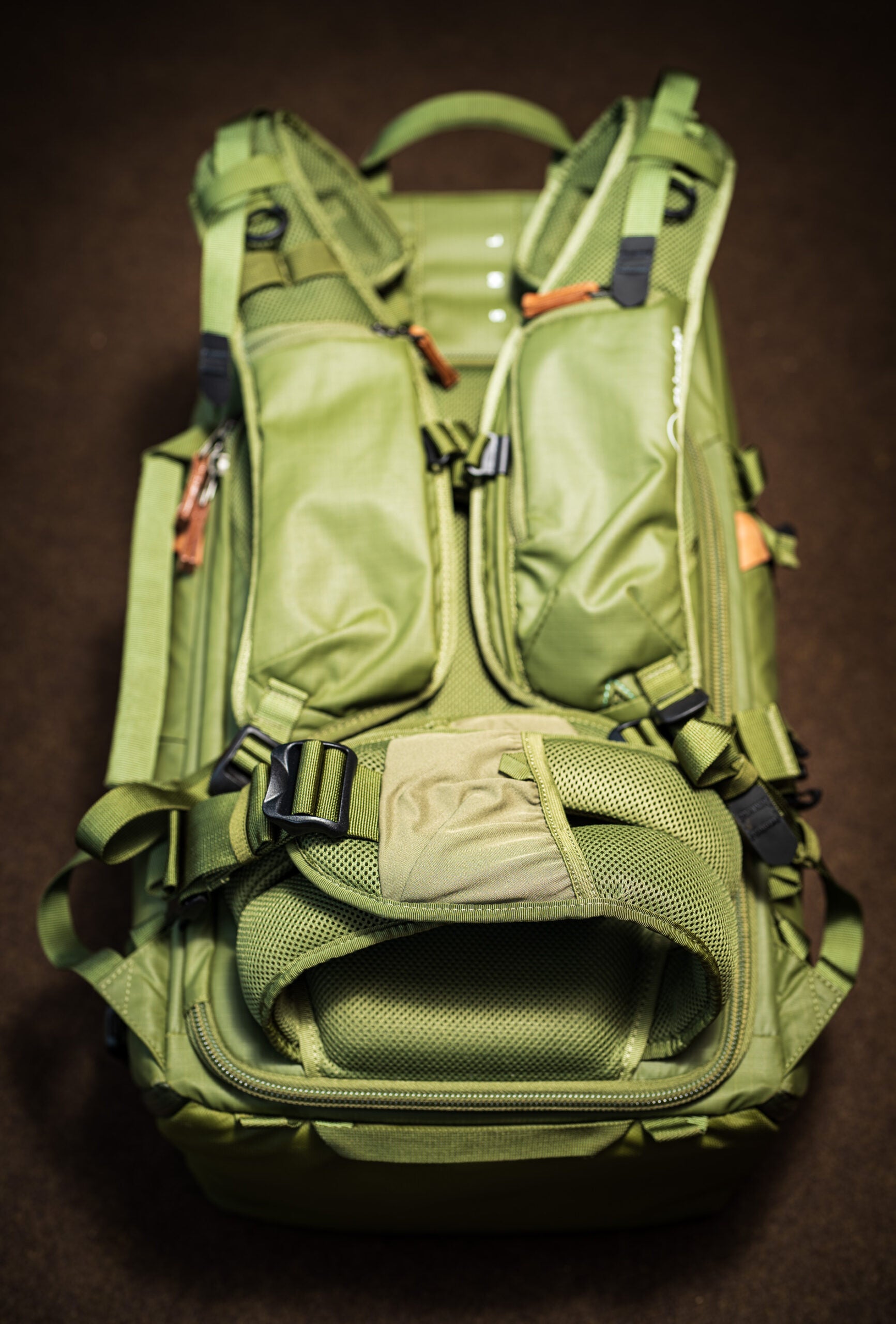
It’s always been a challenge for camera pack designers to place the hip belts of the bags in a way that doesn’t hinder access to the large back opening. Millar has integrated the hip belt into the “hatch” so when open it is out of the way. He has also designed the supportively padded belts to be completely removable, which is a wonderful option for people who don’t want or need a hip belt. This is a very thoughtful feature and one I’ve come to expect from every camera backpack I consider. I’m a large guy and hip belts don’t ride well on my hips, so they can’t transfer any of the pack’s weight to my pelvis. This is a common issue for people with larger physiques, and the removable hip belt is a wonderful thing for me.
I also find the shoulder straps are so well designed that I can carry a 40-pound load for miles with no discomfort. The Version 2 straps also feature new perforated closed-cell foam padding that breathes well, while cushioning the straps. This cooler padding is also found on the back panel of the packs, making for much less sweat on warm days, something I very much appreciated on a muggy visit to Mono Lake last September.
It’s a Crowded Field (or Mountain)
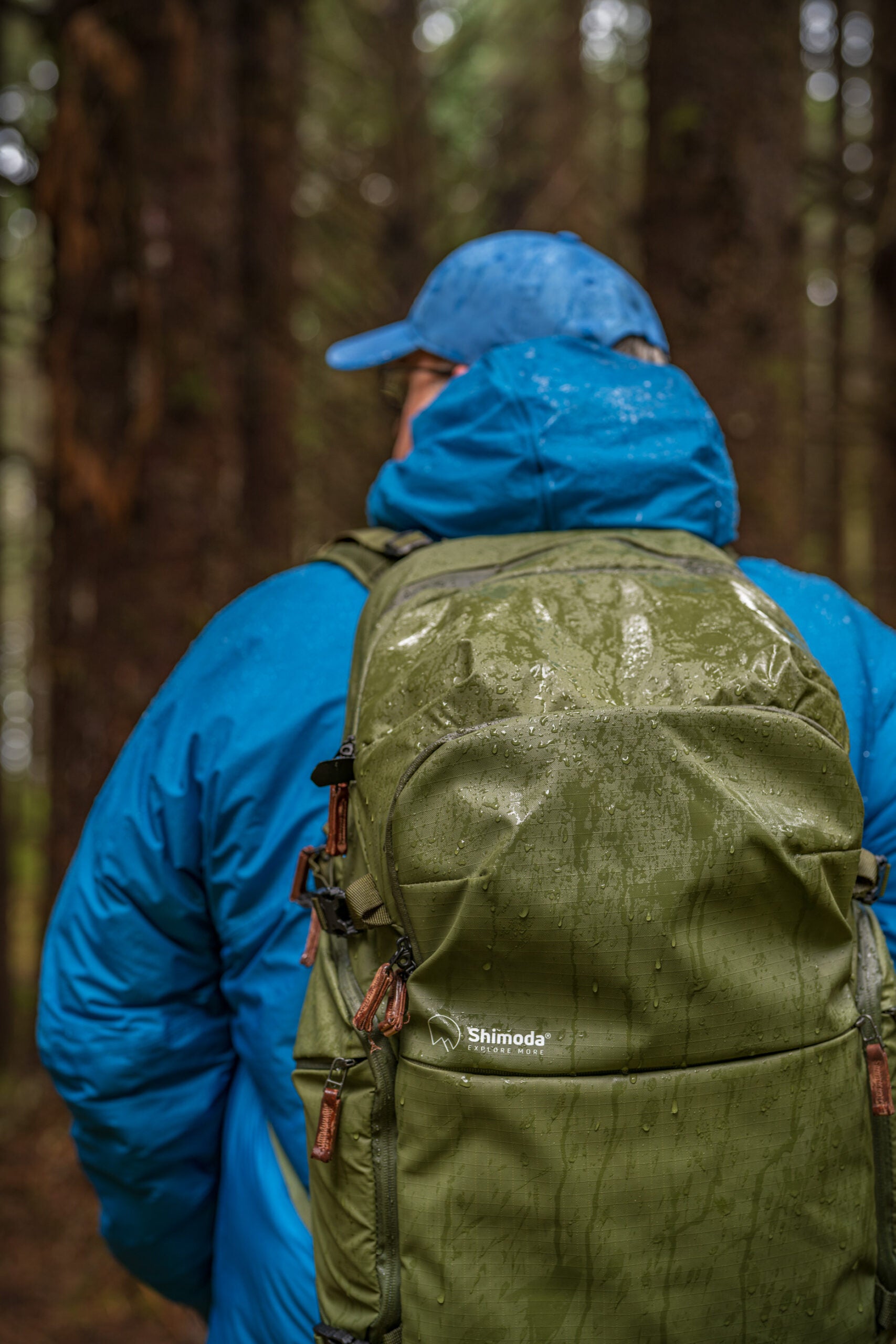
There are several good options for adventure-ready camera backpacks. Established brands such as LowePro, F-Stop Gear, Gura Gear, Peak Design, and Mindshift Gear have been selling well-made packs for years, and newcomers NYA-EVO, Nomatic, and Wandrd are bringing innovative designs to the marketplace. Of the myriad of camera backpacks out there, only F-Stop Gear, NYA-EVO, Wandrd, and Peak Design make packs that utilize removable camera storage units. The other packs have built-in padded storage compartments with adjustable dividers, but the internal space devoted to these are fixed, essentially making these packs dedicated camera gear bags with little room for extra gear such as clothing and food.
I think the option to flex the amount of camera storage within the pack is critical as it allows for a single pack to be customized for each outing. A quick hike to a favorite sunset location might only require a single body, a couple of lenses, and a tripod. By utilizing a smaller camera unit, you cut down on unnecessary weight and bulk, and leave room for extra clothing layers and even snacks. Conversely, certain trips may require a full load of multiple bodies, lenses, and accessories necessitating a larger camera unit. This flexibility is the chief benefit of interchangeable camera units, and why so many travel and adventure photographers are reaching Shimoda Designs packs.
Who It’s For
The Shimoda Designs Explore v2 Series of packs occupy a lofty place in a market filled with incredible products. These refined backpacks have the materials and construction to withstand extreme conditions, yet look sleek and elegant. Gone are the dangling straps and shiny fabrics of the first-generation Explore packs.
Version 2 brings better padding in the back panel and shoulder straps, more robust water-resistant zippers, and ripstop nylon fabric that holds up to the rigors of adventure travel while looking quite classy in matte black or olive green. Given the Shimoda Designs heritage of utility, durability, and comfort, these new Explore packs are for anyone who needs to travel with camera gear in unpredictable conditions and wants to look good doing it. Hardcore action sports photographers will want to look to Shimoda’s Action X line of packs for their expandable capacities, but most everyone else will find what they are looking for in the Explore line.
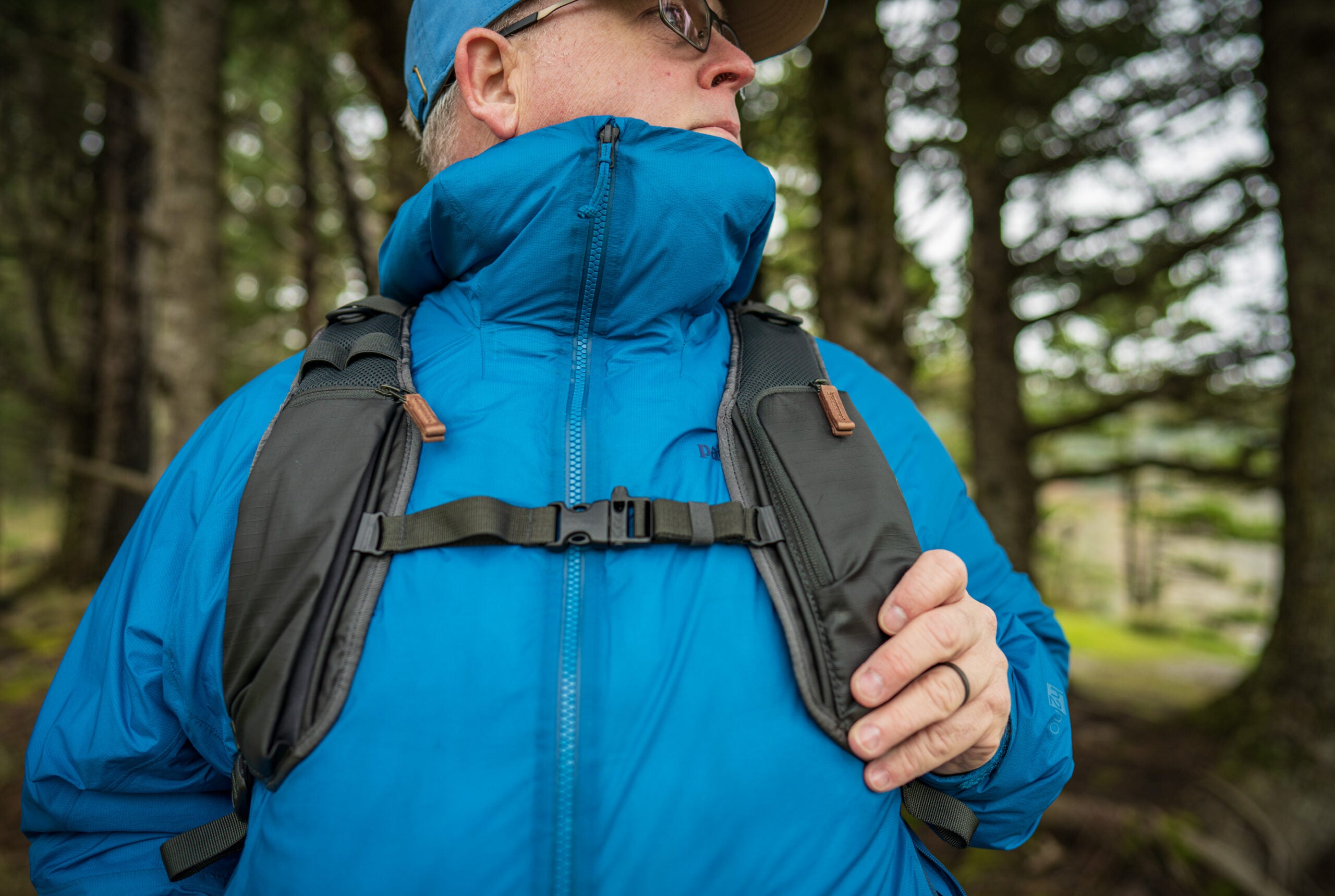
If you’re a globe-trotting photographer with a small to moderate kit (one body and three or four lenses), the Explore 25 is going to whisk by the strictest gate agents and allow you to navigate busy city streets without bowling people over. I think it’s the perfect size for all-day use. The 25-liter capacity will keep you from overloading, but the small mirrorless Core Unit will take on a surprising amount of gear. The thoughtful pockets and organizational touches will keep everything in easy reach but safely tucked away behind leather-trimmed zippers. I opted for the matte black color for my Explore 25L and I am confident it will endure years of adventures.
If you want to fly internationally but need to haul more gear, the 30-liter Explore will suit you if you pack it carefully. With any of the mirrorless camera Core Units installed, the Explore 30L will carry an impressive kit, including long lenses like 100-400 zooms. Thanks to the side compression straps, you will be able to cinch the pack down to satisfy airport skeptics and the 30L will fit in any overhead compartment.
If your travels usually involve domestic flights or car jaunts, the Explore 35L is the best option. With a mirrorless Core Unit inside, it can swallow large coats and scads of accessories for long adventures. Load it down with one of the deeper DSLR Core Units and the Explore 35L becomes a heavy hauler capable of managing sprawling landscape kits and some small video rigs. For me, the Explore 35L is the bag I turn to the most, especially when I am working from a car and I don’t want to leave anything behind. Even fully loaded it carries comfortably for miles. I could see wedding and event photographers loving the Explore 35L and it’s capacious elegance.
Conclusion
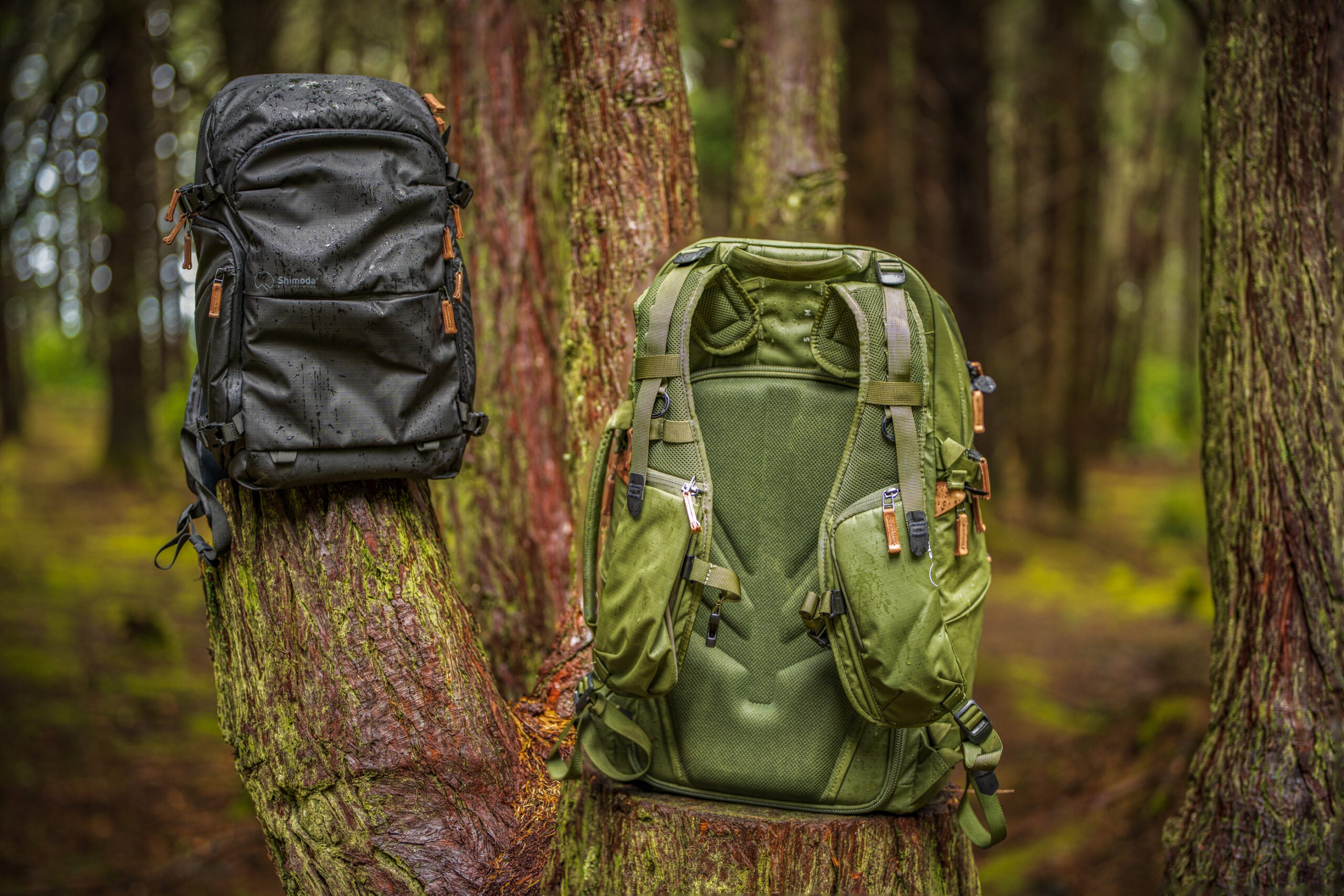
When Ian Millar dreamt up the original Explore camera backpacks, he created a series of bags that checked a lot of boxes for photographers who were looking for comfortable, durable, and thoughtful ways to get loads of gear to their favorite places. With miles and miles of lessons learned, he’s back with a new line of Explore packs that add better materials and refined design for a line of camera backpacks that will sit as nicely on the back as they fit in the overhead bin. Over 2,500 people snatched up these packs when Shimoda launched them on Kickstarter, and now they’re on store shelves.
Competitors in the camera backpack space have a lot to offer to those looking for well-made packs that can haul a lot of equipment, but I think Shimoda Design has the best combination of shoulder straps, interchangeable camera Core Units, materials and aesthetics. The Explore v2 series of packs have all of the weather-defying materials you’ll find on F-Stop Gear and NYA-EVO packs, but without the mountaineering styling and aggressive branding. They have the refined look of Peak Design’s popular Everyday and Travel packs, but shoulder straps you won’t regret using. The Explore Vv2 packs are the best camera backpacks for those who seek the light below the timberline and on crowded streets.
Pros & Cons
Pros
- Superior suspension system (adjustable and comfortable)
- Incredibly durable and weather-resistant materials
- A large range of camera Core Units provide flexible options
- Three sizes to meet travel requirements
- Thoughtful organization throughout
- Subdued colors and branding
Cons
- Expensive
- Shoulder straps don’t stow easily for travel
- Side pockets can be difficult to use
- Laptop storage is cumbersome for larger laptops
- Camera Core Units are sold separately
The post Shimoda Explore v2 review – a versatile camera backpack for nearly any adventure appeared first on Popular Photography.
